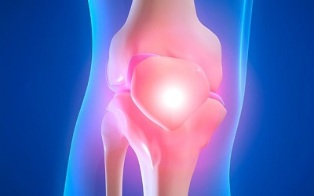
In the group of diseases of the musculoskeletal system of degenerative-dystrophic origin, the knee joint of the knee joint takes the first place.
Gonarthrosis or arthropathy of the knee joint is a disease that is accompanied by slow destruction of the cartilage tissue of the joint with the involvement of the entire joint in the pathological process, including ligaments, articular, subchondral bone and other bones. joint.Under the influence of various factors, such as infectious diseases (colds, flu, typhoid, tuberculosis, syphilis, tonsillitis, etc. ), injuries, functional congestion of the joint (for example, in athletes, workers who work hard)ballet) there is a violation of the nutrition (nutrition) of the cartilage tissue of the knee joint, with the result that the cartilage becomes thinner and is destroyed, sometimes for complete disappearance.
But in general, gonarthritis is a disease of the elderly. And there is a simple explanation for this. As you know, cartilage tissue is about 70-80% water, due to which it absorbs well. In addition, at a young age, chondrocyte "repair" cells function actively. Over time, the amount of moisture begins to decrease and, consequently, the ability of the joint to absorb deteriorates, the cartilage becomes dry, brittle and cracked, and the existing chondrocytes do not have time to repair damage. In many ways, this explains the appearance of a knee joint.Who is at risk? First of all, arthritis of the knee joint is in danger of "winning" women over forty, they have it twice as often as the strong half of humanity. In addition, the risk increases in those women who tend to be overweight or obese.
Causes of the disease
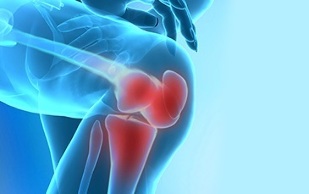
Predisposing factors are overweight, physical inactivity, chronic joint injury or systemic joint trauma, alcohol abuse, chronic stress, previous or existing joint diseases such as: z>
- knee arthritis,
- sprain, partial or complete rupture of ligaments,
- intra-articular fracture of the thigh or tibia,
- metabolic disorders, such as gout and certain other pathological conditions.
Also, the disease, for reasons of appearance, is usually divided into two forms: primary and secondary.
Primary arthropathy is caused by age and related factors, such as:
- Professional disposition,
- Overweight,
- Obesity, Varicose veins of the lower extremities.
The cause of secondary knee arthritis may be a previous knee injury (fracture, ligament rupture), called post-traumatic knee joint disease. The same reason may be a previous infectious disease or inflammation of the knee joint.
Symptoms
Signs of knee joint pain do not appear overnight, the disease develops gradually and often lasts for several months, or even years. Pains that are permanent and increase with physical activity - walking, running, descending or climbing stairs and so on - come to the fore. Another symptom characteristic of this disease is the presence of a bulge in the joint, it can be crackling or critical in the knee.
Also very common knee manifestations are:
- increase in local temperature (joint is warm to the touch) or general,
- presence of swelling in the joints,
- increasing its volume,
- difficulty moving,
- deformity of the joint followed by curvature of the limb.
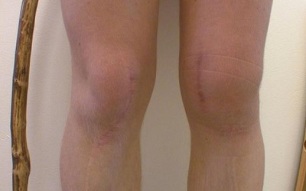
As the disease progresses, when the cartilage tissue is completely destroyed, the body has no choice but to start defending itself. This is manifested by the proliferation of bone tissue in the bones that form the joint in the form of "thorns" (osteophytes), there is a deformed arthropathy of the knee joint. Exudate occurs in the articular cavities.
Depending on the size of the osteophytes and the degree of deformity, there are different degrees of knee joint:
- Knee joint grade 1.Patients experience stiffness and mild joint pain in the morning or when sitting or standing for long periods of time. There is no joint deformity at this stage, mobility remains complete. An x-ray reveals a small osteophyte.
- Knee joint grade 2.Painful sensations appear, not only in the morning, but also after prolonged exercise, the joint is deformed, the joint surfaces are enlarged, as a result of which the volume of the joint also increases, thebending is difficult, a crisis is felt when performing movements. The x-ray shows a strong osteophyte, the joint space does not change.
- Knee joint grade 3.The manifestations are the same as those of the second degree, only the symptoms become more intense. The pain is permanent, it does not subside even in rest and sleep. Joint function is almost completely lost, patients can neither bend the leg nor straighten it. As a result, lameness occurs, movement is possible only with crutches or with external assistance. There is a severe deformity of the knee joint. X-rays show a slight narrowing of the joint space.
- There is also a fourth stage, in which there is complete immobility in the affected joint with further deformity. Radiography identifies the effects of hypochondriac bone hardening and a significant narrowing of the joint space.
Treatment of knee joints
To achieve good treatment results, you should seek the help of a qualified rheumatologist, and if he is not there, then a therapist, as he knows how to treat knee joint arthropathy. Under no circumstances should you try to deal with it on your own, this can only worsen an already no better situation. Before starting treatment, it is extremely important to make the right diagnosis, as the right diagnosis is the key to successful treatment.
Knee treatment is a fairly long process and depends on several factors (type of joint, cause of the joint, degree of the disease). Treatment is complex and includes pharmacological and non-pharmacological treatment, and in some cases surgical treatment is indicated.Medication of the knee joint is mainly aimed at relieving the main manifestations of the disease, such as:
- Pain?
- Inflammation of the joints and periarticular tissues.
In addition to relieving the symptoms of the disease, medicines are used to:
- repair of joint tissue,
- improving nutrition and blood circulation,
- strengthening the body's defenses,
- elimination of allergic reactions.
Various non-narcotic analgesics are used to relieve pain symptoms, in rare cases, narcotic analgesics are prescribed for a short time. Most often, drugs are used by the group of non-steroidal anti-inflammatory drugs. They have a combined anti-inflammatory, analgesic and antipyretic effect.
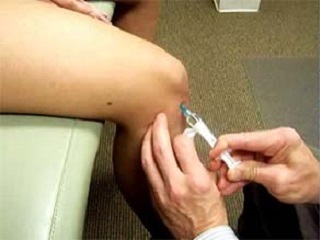
Cartilage protectors are used to repair cartilage tissue and improve joint mobility. Drugs stimulate the activity of cartilage-chondrocytes and help them repair tissue. Intra-articular insertion of head protectors gives a good result. In recent years, a new, effective product based on hyaluronic acid has emerged. For its action, this drug is called "liquid addition". Once injected into a diseased joint, this drug forms a protective film on the damaged cartilage and gradually restores the normal lubrication characteristics of the joint.
Muscle relaxants are used to relieve muscle spasms, in addition to a relaxing effect, they have a positive effect on blood circulation to the affected joint.
Manual and physical therapy is widely used by non-drug methods to treat knee joint. The most important are magnetotherapy, acupuncture, electrophoresis and massage, device traction (joint extension) and more. Recently, methods such as laser therapy, cryotherapy (exposure to liquid nitrogen) have entered the practice of treating arthropathy. Along with physiotherapy, exercise for the knee joints also gives a good result. Lfk is the use of various physical exercises for therapeutic purposes.Gymnastics for the knee joint
At the onset of the disease, physical activity in the disease should be minimized. You should not jog, jump, lift weights, walk fast, squat. Exercises for knee joints can only be performed after a treatment, under the supervision of your doctor.
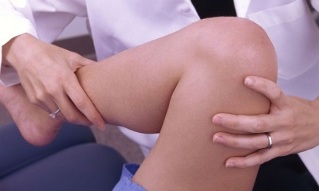
It is necessary to choose exercises that help strengthen the muscles and ligaments of the affected knee joint, but at the same time do not lead the joint to excessive mobility. That is, the exercises should be with minimal dynamic activity. It is useful to do exercises to stretch the joints and capsules of the joints. The rules are the same, the exercises are performed gently, without effort.
When doing any exercise, it is important to follow certain rules:
- Do not exercise excessive pain
- If exercise causes pain, then it should be replaced by another milder one.
Massage for knee joints has a beneficial effect in restoring the functions of the knee joint. At the site of exposure, blood vessels dilate, blood circulation improves and metabolism is accelerated. Massage procedures improve lymph flow and this, in turn, helps eliminate residual inflammation. Massage strengthens the muscular system, increases the flow of oxygen in them, improves gas exchange, normalizes their tone and increases plasticity.
Nutrition for knee joints
Recently, medical experts have found that there is no direct link between the impact of knee flexion and diet. However, it is an indisputable fact that the development of the joint is greatly affected by the presence of overweight in a person. If the cause of the disease was precisely the excess weight, then it is obvious that the diet for knee joints should be aimed at the gradual reduction of body weight. This will require a change in diet and a change in diet. Foods should have fewer calories, fried foods and high fat foods should be excluded from the diet. Eat more vegetables, fruits and fluids.
Prevention of knee joint joints
In order for the joints to stay as healthy as possible, it is necessary to exercise regularly and exercise, but do not get too carried away with it, so as not to lead to overload of the joints. Swimming gives the best result and minimal stress on the joints. If professional sports are involved, joint protection should be used. It is useful to alternate physical activity with rest, you should not stay still for a long time.
Adherence to all these simple rules, along with a healthy lifestyle and proper nutrition, will not allow the knee joints to ruin any person's life.




































